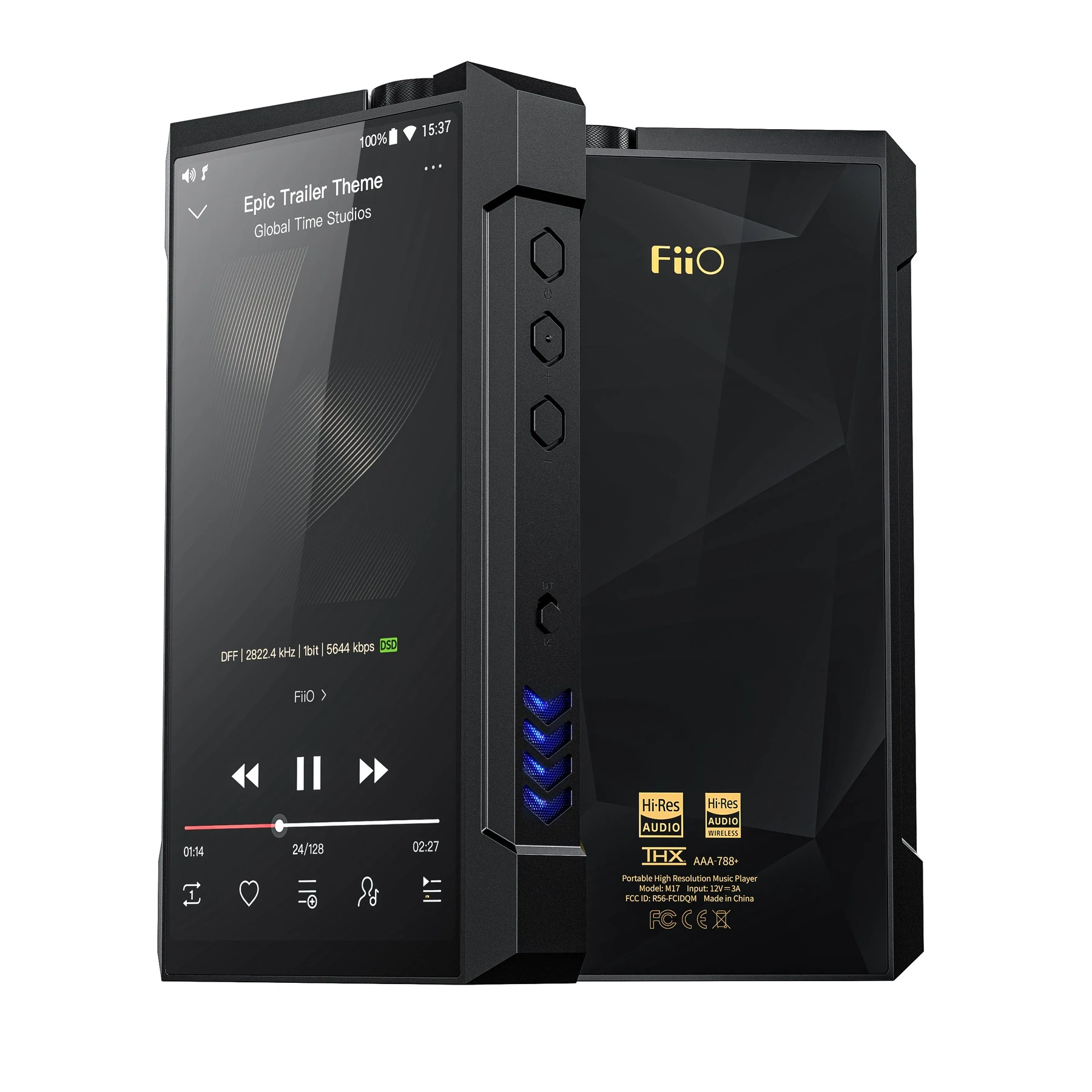
FiiO M17 vs FiiO M11
If you’ve narrowed down your DAP purchase options to the FiiO M17 and FiiO M11 Plus ESS, you’re probably wondering if the M11 is a better value. Why spend an extra $1,100 if you don’t have to, right? We hear you.
Putting it all on the table
Let’s put it all on the table (literally). Below is a comparison chart between the DAPs. We’ve highlighted the instances where one DAP has clearly bested the other.
|
Category |
FiiO M17 |
FiiO M11 Plus ESS |
|
Price |
$1,799.99 |
$699 |
|
CPU |
Qualcomm Snapdragon 660 octa-core |
Qualcomm Snapdragon 660 octa-core |
|
DAC chip |
ESS ES9038PRO x2 |
ESS ES9068AS x2 |
|
Amp chip |
THX AAA-788+ |
THX AAA-78 x2 |
|
USB chip |
XMOS XUF208 |
XMOS XUF208 |
|
Bluetooth chip |
QCC5124 |
QCC5124 |
|
RAM |
4GB |
4GB |
|
Bluetooth version |
5.0 |
5.0 |
|
Max sample rate |
32-bit/786kHz, DSD512 |
32-bit/768kHz, DSD512 |
|
Max output power |
1.4W @16Ω |
400mW @16Ω |
|
MQA |
Yes, 8x unfold |
Yes, 8x unfold |
|
All to DSD |
Yes |
Yes |
|
Equalizer |
10-band EQ |
10-band EQ |
|
Volume potentiator |
Analog knob |
Digital slide or button control |
|
FiiO Link |
Yes, Wifi and Bluetooth control |
Yes, Wifi and Bluetooth control |
|
In-vehicle mode |
Yes |
Yes |
|
OTA upgrades |
Yes |
Yes |
|
Battery capacity |
9,200 mAh |
6,000mAh |
|
Max average battery life |
10 hours |
14 hours |
|
Screen size |
5.99” |
5.5” |
|
USB port |
USB Type-C 3.0, USB Type-C 2.0 |
Type-C |
|
Max SNR |
123dB |
120dB |
|
Max THD+N |
<0.0007% |
<0.0006% |
|
Charging time |
4.5 hours |
3 hours |
|
Total storage |
64GB |
64GB |
|
Expansion storage |
Up to 2TB |
Up to 2TB |
|
Gain modes |
Low, medium, high, enhanced headphone mode |
Low, medium, high |
|
Outputs |
6.35mm headphone, 4.4mm balanced, 3.5mm headphone/line out, 2.5mm balanced, RCA coax |
2.5mm balanced, 3.5mm SE, 4.4mm balanced, 4.4mm balanced line out |
|
Inputs |
RCA coax, USB 3.0, USB 2.0 |
USB Type-C |
|
WiFi |
2.4GHz/5GHz |
2.4GHz/5GHz |
|
Weight |
1.3lbs |
0.65lbs |
As you can see, the race between these two is way closer than their price difference would suggest. They use the same CPU, USB chip, and Bluetooth chip. Their storage sizes are identical, as are their WiFi specs.
So where do they differ, and does it matter? The FiiO M17 has the better DAC chip and amp chip, but the real-world differences between the two are marginal. For instance, the M17’s SNR is a mere 3dB higher than the M11 Plus, which realistically isn’t something you’d notice. And just because the M17’s chipset is better doesn’t mean that the M11 Plus’ is bad. In fact, it’s great. It decodes at the same max sample rate as the M17 (32-bit/768kHz, DSD512).
Ironically, the M11 Plus, with its relatively inferior chipset, actually performs better than the M17 in certain categories, such as THD+N. Now, the difference between the two is tiny (0.0007% vs 0.0006%) and completely imperceptible unless you’re a THD+N-measuring machine, but it serves as a reminder that a DAP’s final measurements are a result of every component in the system. You can have the best DAC chip in the world (and some might argue that the ESS ES9038PRO is), but its spotless THD+N can get brought down by other noisy components in the system.
THD+N isn’t the only example of the M17 performing at the same level as the M11 (or worse) despite its relatively superior hardware. Take the battery. The M17 has a 9,200mAh battery, whereas the M11 Plus has a much smaller 6,000mAh battery. You might assume that the M17’s larger battery gives it a longer battery life, but you’d be wrong. The M17 has an average battery life of 10 hours, whereas the M11 Plus has an average battery life of 14 hours. For whatever reason–less efficient hardware, power-hungry features–the M17’s battery won’t take you as far as the M11’s battery.
Now, there are a few areas where the M17 is clearly better than the M11 Plus. One is its analog volume potentiometer. Unlike a digital volume potentiometer, an analog potentiometer doesn’t suffer from software-induced lag. Plus, an analog potentiometer is just nicer and feels great to use. Another example is the M17's RCA coax input/output. The RCA coax input/output opens the possibilities for adding analog components to your audio chain, such as a tube pre-amp. Two others are the USB 2.0 (in addition to USB Type-C) input (which means that you can connect older-generation sources without using an adapter) and the enhanced gain headphone mode. Whether or not those features are deal-breakers depends on if you plan on using them or not.
So which should you choose? At the end of the day, the M11 Plus is a much better value. At $699, it covers nearly all of the same bases as the M17 and even exceeds the M17 in certain crucial categories like battery life. For almost all audiophiles, the M11 Plus is the clear winner.
But if you want the best of the best, and the higher cost isn’t a problem, the M17 is the way to go. Its analog volume potentiometer and RCA coax in/out are especially cool features, and its 1.4W maximum output power will drive nearly anything.


